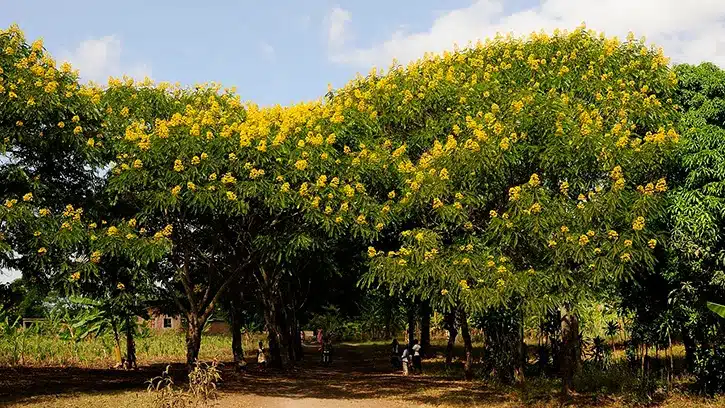About Senna spectabilis:
- It is a species of the legume family.
- It is a medium to big tree native to South and Central America and is grown as an ornamental plant as it has bright yellow flowers.
- It is a fast-growing species, particularly on deep soils, and is fire- and termite-resistant and tolerant of strongly acidic soils.
- It is often planted for fuelwood, as an ornamental, and as a shade tree in agroforestry situations.
- It is classified as an Invasive Alien Species (IAS) in India.
- It is considered an environmental weed by the Global Compendium of Weeds.
- In India, it was introduced as shade trees for coffee and firewood; it soon became a threat to native tree species as its dense foliage prevented the growth of other indigenous trees and grass species.
- It is classified as Least Concern under the IUCN Red List.
Key Facts about Wayanad Wildlife Sanctuary:
- Location: It is located in Wayanad, Kerala, in the southern trenches of the Western Ghats.
- It is an integral part of the Nilgiri Biosphere Reserve, which is a UNESCO World Heritage Site.
- It is bordered by the protected areas of Nagarhole and Bandipur in Karnataka on the northeastern side and Mudumalai in Tamil Nadu on the southeastern side.
- Tribes living in these forests include some scheduled adivasis, such as Paniyas, Kattunaikkans, Kurumas, Ooralis, Adiyans, and Kurichiyas.
- Flora:
- It is a mosaic of the Western Ghats’ significant vegetation types, ranging from moist deciduous to dry deciduous and semi-evergreen patches.
- Teak, rosewood, eucalyptus, and silver oakplantations cover roughly one-third of the sanctuary.
- Marshy lands also mark their presence in the sanctuary.
- Fauna:
- It is also home to animals like elephants, panthers, tigers, jungle cats, civet cats, monkeys, wild dogs, bisons, deer and bears.
- It is known for having the largest population of tigers in Kerala.
Q1: What are Invasive Alien Species?
These are the species whose introduction and/or spread outside their natural past or present distribution threatens biological diversity. These include animals, plants, fungi, and even microorganisms, and can influence all kinds of ecosystems. These species need an introduction either through natural or human intervention, survive on native food resources, reproduce at a fast rate, and edge out native species in the competition over resources. Invasive species act as disruptors in the food chain and disturb the balance of the ecosystem. In habitats where there is no competition, invasive species can dominate the entire ecosystem.
Last updated on July, 2025
→ UPSC Notification 2025 was released on 22nd January 2025.
→ UPSC Prelims Result 2025 is out now for the CSE held on 25 May 2025.
→ UPSC Prelims Question Paper 2025 and Unofficial Prelims Answer Key 2025 are available now.
→ UPSC Calendar 2026 is released on 15th May, 2025.
→ The UPSC Vacancy 2025 were released 1129, out of which 979 were for UPSC CSE and remaining 150 are for UPSC IFoS.
→ UPSC Mains 2025 will be conducted on 22nd August 2025.
→ UPSC Prelims 2026 will be conducted on 24th May, 2026 & UPSC Mains 2026 will be conducted on 21st August 2026.
→ The UPSC Selection Process is of 3 stages-Prelims, Mains and Interview.
→ UPSC Result 2024 is released with latest UPSC Marksheet 2024. Check Now!
→ UPSC Toppers List 2024 is released now. Shakti Dubey is UPSC AIR 1 2024 Topper.
→ Also check Best IAS Coaching in Delhi















